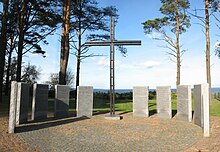Toila (village)
Coordinates: 59 ° 25 ' N , 27 ° 31' E
The village of Toila ( Estonian Toila alevik ) is located in the Ida-Viru district ( East Wierland ) in northeast Estonia . It is the capital of the rural community of the same name ( Toila vald ).
Description and history
Toila is about forty kilometers from the city of Narva . The village has 920 inhabitants (as of March 1, 2012). It is right on the Gulf of Finland . Toila is known by day trippers for its Baltic Sea beaches. There is a small marina in the village.
Toila was first mentioned in 1428 under the name Tulis . The courtyard was built at the beginning of the 17th century. In 1765 the manor Toila was mentioned.
Summer retreat
From the middle of the 19th century, the until then sleepy Toila developed into a popular air recreation area. Numerous Russian, German Baltic and Estonian townspeople moved here for their summer retreat .
With the construction of the railway line between the Estonian capital Tallinn and the Russian capital Saint Petersburg in 1870, the tourist development of Toila increased rapidly. Numerous summer houses were built on the Baltic coast and on the banks of the Pühajõgi River .
From 1897 to 1899 the Petersburg businessman Grigori Jelissejew had the Oru Castle built in Toila . The gigantic building with 57 rooms stood in a spacious park with native and exotic tree species. The luxurious construction cost five million rubles. The house housed a valuable art collection. In 1935 Estonian industrialists acquired the property and gave it to the Estonian President Konstantin Päts as a summer residence. The castle was completely destroyed in 1941 during the Second World War. The park is preserved.
After the First World War , with the independence of the Republic of Estonia, Toila's development as a recreational destination continued. The numerous artists and intellectuals who spent the summer months in Toila included Henrik Visnapuu , Friedebert Tuglas , Artur Adson , August Gailit , Betti Alver , Valmar Adams , Aleksis Rannit , Johann Köler and Paul Pinna . In 1918 the Russian poet and translator Igor Severjanin (1887–1941) emigrated to Toila.
Today there is a large sanatorium in Toila, which was extensively restored and modernized after Estonian independence was regained.
In economic terms, in addition to fishing and tourism, Toila also had one of the largest dairies in Estonia from 1911 before the First World War.
Country theater
Toila also became known as the site of the first Estonian country theater. It was founded in 1881 by the socially and culturally active farmer Abram Siimon (1844–1929). When the theater burned down in 1901, the patron had a new stone building built. Today a memorial stone commemorates the theater life in Toila.
German military cemetery
On August 10, 2002, the Toila German military cemetery was inaugurated in the immediate vicinity of the Ostsee- Klint . From the military cemetery there is a wide view of the Gulf of Finland. The war cemetery is under the care of the Volksbund Deutsche Kriegsgräberfürsorge eV More than 1,500 Germans and 600 Estonian soldiers killed in World War II have found their final resting place there.
The cemetery goes back to the German military cemetery, which was created in 1944 for 2,000 fallen from the Narva Front . After the war, parts of the cemetery were used as a training area for Soviet border troops. It is thanks to the vastness of the site that only a small part of the grave sites was destroyed.
Web links
- Detailed description of the place (Estonian)
Individual evidence
- ↑ Population 2012 ( Memento from February 18, 2012 in the Internet Archive )
- ^ Thea Karin: Estonia. Cultural and scenic diversity in a historical borderland between east and west. Cologne 1994 (= DuMont art and landscape guide ) ISBN 3-7701-2614-9 , p. 141
- ↑ http://www.eestigiid.ee/?CatID=91&ItemID=856
- ↑ Indrek Rohtmets: Kultuurilooline Eestimaa. Tallinn 2004 ( ISBN 9985-3-0882-4 ), p. 190
- ↑ Archived copy ( memento of the original from August 21, 2012 in the Internet Archive ) Info: The archive link was inserted automatically and has not yet been checked. Please check the original and archive link according to the instructions and then remove this notice.
- ↑ http://www.volksbund.de/kriegsgraeberstaetten.html




